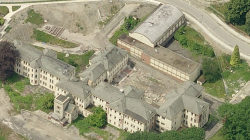Woodlands Institution
| Woodlands Institution | |
|---|---|
 Main Building | |
| Construction Began | 1876 |
| Opened | 1878 |
| Closed | 1996 |
| Demolished | 2007 |
| Current Status | Demolished |
| Building Style | Single Building |
| Location | New Westminster, BC |
| Peak Patient Population | 1,400 in 1959 |
| Alternate Names |
|
Contents
History
Woodlands institution opened in New Westminster on May 17, 1878 as the Provincial Asylum for the Insane, later re-named the Provincial Hospital for the Insane. In 1950 it was renamed Woodlands School and in 1974 the name was changed again - to Woodlands. Although the asylum was originally presented as a modern approach to treating “lunatics” and the “feebleminded, it was soon criticized as gloomy and unfit for its purpose of caring for people today referred to as having psychiatric disabilities and intellectual disabilities.
The philosophies of care and treatment changed over the decades, from custodial care and confinement to hospital or medical care to education and development. In the 1920’s, authorities decided that the Woodlands site would serve only people with intellectual disabilities, and other residents were moved to Essondale. While there were many exemplary staff at Woodlands and notable efforts - as early as 1885 - to ensure appropriate treatment of residents, inquiries and investigations into conditions, treatment and mistreatment of residents occurred in virtually every decade of Woodlands’ existence.
Abuse and overcrowding were problems throughout its history. The 1940s saw a significant increase in staff training and the focus of the institution shifted to education in the 1950s. By the late 1950's there were approximately 1400 people living at Woodlands. Due largely to the advocacy efforts of families, in 1981 the provincial government announced plans to close Woodlands.
Community placements were planned and implemented over the next 15 years. Woodlands finally closed in 1996, marking the culmination of a long struggle to end large institutions in British Columbia. It was B.C.'s main facility for people with mental disabilities until it was closed in 1996. In July of 2008, most of the remaining original building was destroyed by a 4 alarm fire. The property has been sold to private developers who are building condominiums at various locations on the site.
Timeline
- May 17, 1878: Opens as the Provincial Asylum for the Insane.
- 1900: Woodlands, now called the Public Hospital for the Insane, has a capacity of 310 patients.
- 1930s: Emphasis changes to the housing of people with developmental disabilities, and training and education become factors.
- 1950: Its name is changed to Woodlands School.
- 1959: Woodlands' resident population peaks at about 1,400.
- 1970s: Woodlands houses about 800 residents, 75 per cent of them described as severely or profoundly retarded. It has about 1,200 staff, including nurses, housekeepers, dietary staff, social workers, psychiatrists and physicians, and vocational instructors.
- 1980s and '90s: Woodlands residents are gradually de-institutionalized and placed in community settings. By January 1996, only 70 residents remain, and later that year it becomes the last institution of its kind in B.C. to be closed permanently.
Source: B.C. ministry of children and family development.
Images
Cemetery
Attached to Woodlands was a cemetery where over 3,300 former residents of Woodlands were buried. When the construction of Queen's Park Hospital began in 1977 beside the Woodlands property, the cemetery was closed and made into a park. At that time over 1,800 grave markers were removed and all but a few hundred were "recycled" or disposed of. Some were used to make a barbeque patio on the Woodlands site for the use of staff. Others went off site for use at construction sites, and others were used to build retaining walls for the creek flowing through the Woodlands property.
In 1999, the BC Self Advocacy Foundation and the BC Association for Community Living, with the support of the provincial government, began planning the Woodlands Memorial Garden. The garden was designed by Erik Lees and Associates, who received a partnership award from BCACL for their dedicated and creative work on the garden. The memorial garden design includes three key elements. A memorial sculpture called the "Window Too High" references the experience of institution residents who could not see out of the high barred windows.
A reflective pond uses a pattern of stones under water that echoes the pattern of burials in the cemetery. And finally, the names of all those buried in the cemetery were restored to memorial walls placed in groups along a pathway that circles the cemetery site. Each memorial wall has an inset into it grave markers that have been salvaged, along with plaques engraved with names of those whose stones were not recovered.


